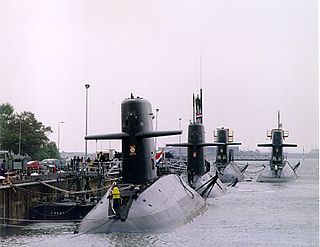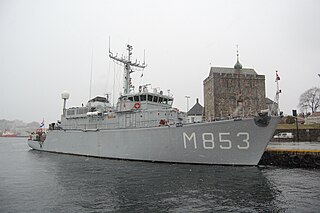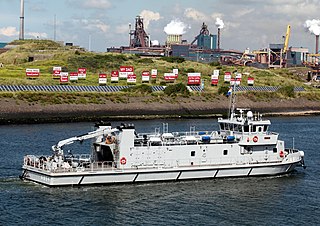
The Royal Netherlands Navy is the naval force of the Kingdom of the Netherlands. It is one of the four Netherlands Armed Forces. It was founded on 8 January 1488, making it the third oldest naval force in the world.

The Karel Doorman-class frigates are a series of eight multi-purpose vessels built for the Royal Netherlands Navy. Its namesake is Karel Doorman, a Dutch naval officer whose ship was struck by a Japanese torpedo in the battle of the Java Sea in 1942, and who, as a result of which, went down with his ship.

The Walrus-class submarine is the only submarine class currently in operation in the Royal Netherlands Navy. The boats have been in service since 1990 and are all named after sea mammals.

HNLMS Karel Doorman is a multi-function support ship for amphibious operations of the Royal Netherlands Navy, which is also used by the German Navy. The ship replaced both of the navy's replenishment oilers: HNLMS Zuiderkruis and HNLMS Amsterdam. At 204.7 m she is the largest ship in service with the Royal Netherlands Navy.

The Alkmaar class is a ship class of fifteen minehunters that were built in the Netherlands for the Royal Netherlands Navy. They are based on the design of the Tripartite class, which was developed by a collaborative effort between the Netherlands, Belgium and France, and replaced the minesweepers and minehunters of the Dokkum class.

The Anti-Submarine Warfare Frigate (ASWF) is a project of the Royal Netherlands Navy and Belgian Navy to replace the existing Multipurpose- or M-frigates. The project shows similarities to the British Global Combat Ship but development is fully separate.

HNLMS Mercuur (A900) is a submarine support ship of the Royal Netherlands Navy. The ship was built and designed specially to support the Dutch submarines. She entered service on 21 August 1987, and is the only surface vessel attached to the Dutch submarine service.

HNLMS Tromp (F801) was a frigate of the Tromp class. The ship was in service with the Royal Netherlands Navy from 1975 to 1999. The frigate was named after Dutch naval hero Tromp. The ship's radio call sign was "PADE".
In April 2018, the Dutch Government approved a multi-year investment program for the Dutch Navy and allocated funds for the 2018–2030 period. The Dutch Defence Materiel Administration (DMO) is in charge of the procurement of these new ships.

HNLMS Den Helder is a new replenishment oiler under construction for the Royal Netherlands Navy. Also known as the Combat Support Ship (CSS), Den Helder is planned to fill the gap of replenishment at sea that was left after HNLMS Amsterdam was sold to Peru in 2014.

The Netherlands and Belgium are doing a joint procurement for the replacements of the Tripartite-class/Alkmaar-class minehunters. Both countries want to procure six new mine countermeasure (MCM) vessels, which makes for a total of 12 MCM ships. The new MCM ships will include a range of unmanned systems including unmanned surface, aerial and underwater vehicles alongside towed sonars and mine identification and neutralization ROVs.

The Snellius class are two hydrographic survey vessel (HOV) ships in service with the hydrographic branch of the Royal Netherlands Navy. The ships were built by the Damen Group, with the hull being built in Romania by Damen Shipyards Galați and the fitting out in the Netherlands by Damen Schelde Naval Shipbuilding.

The Cerberus class are four diving support vessels in service with the Royal Netherlands Navy. Built by Scheepswerf Visser at Den Helder, their mission is to help the explosive ordnance disposal unit with bomb disposal and to serve as a platform to train new navy divers.

HNLMS Soemba is a diving support and training vessel in service with the Dutch Navy. The vessel was constructed by Vervaco, Heusden for the Dutch Army as a training vessel for their divers. The current Soemba is the second vessel in the Dutch Navy with this name, following HNLMS Soemba which was scrapped on 12 July 1985.

HNLMS Van Kinsbergen, or MOV Van Kinsbergen is a naval training ship of the Royal Netherlands Navy.
The West Indies Guard Ship (WIGS) is a ship of the Royal Netherlands Navy that rotates about every four to six months in support of the Dutch Caribbean Coast Guard. It can be a frigate but more commonly one of the navy's Holland-class offshore patrol vessels is deployed to the region. This vessel usually carries an NHIndustries NH90 helicopter for search and rescue tasks and pursuit of suspect vessels.

The Auxiliary ship replacement program is set to replace ten auxiliary ships of the Royal Netherlands Navy from various classes by eight new ships which will be built by a Dutch shipyard.

HNLMS Cerberus (A851) is a diving support vessel of the Royal Netherlands Navy. She has been named after the mythical creature Cerberus.

HNLMS Nautilus (A853) is a diving support vessel of the Royal Netherlands Navy.

HNLMS Hydra (A854) is a diving support vessel of the Royal Netherlands Navy.



















